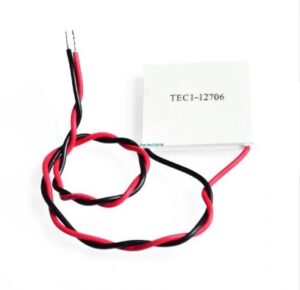Technical Specifications
General Description
The temperature reduction helmet was made by 3D printing using PET-G as the material. In the upper part of the helmet there is a compartment that contains the electronic board to control the whole system.
For cooling have been used n. 5 Peltier cells that, crossed by an electric current, move the thermal energy from one side to the other.
There is therefore a face of the cell that heats and the other that cools. The cells used have a power of 55W, have ceramic surfaces and in order not to exceed the maximum limit on the outer side (the one that heats) have an aluminum heat sink with a fan mounted on it.


Cell Specifications
Chip Type: TEC1-12706
External dimensions: 40*40*3.75 mm 
Internal resistance: 2.1~2.4 (ambient temperature of 23±1’C, 1kHZ Ac test)
Temperature difference between faces: Tmax(Qc = 0) 59 °C.
Operating current: Imax = 4.3-4.6A (nominal at 12 V)
Rated voltage: 12 V (Vmax: 15 V peak current 5.8A)
Cooling power: Qcmax 55 W
Working environment: temperature range: 55 °C ~ 83 °C (both sides)
The power supply to the cells is not provided continuously, but in pulses so as to modulate the amount of heat that must be moved from the inside to the outside.
In order to perform this function, a digital temperature sensor fixed on the side that cools each cell is coupled to the internal part and returns the value with 0.0625 °C steps in a range from -55 °C to +125 °C.
The control board consists of a high-performance dual-core microcontroller capable of measuring the temperature on the 5 cells and varying the ignition of the same independently so as to have a uniform distribution of internal temperature over the entire area concerned.
The total power of the device is 275 W, but once you reach the desired temperature, for its maintenance, are sufficient from 20 to 50W so that with the battery supplied you get an autonomy of operation from 5 to 10 hours.
Inside the helmet there is a foam lining that has the dual purpose of equalizing the internal temperature and give a certain comfort in use in contact with the skull.
Control and Regulation
On the board the microcontroller has a 2.4 Ghz radio interface that is configurable and usable in the following modes:
- WiFi in Access Point mode;
- WiFi in client mode;
- Bluetooth;
In the first mode the device will be assigned an SSID name and a password and then it will be possible for devices equipped with WiFi interface to connect to it.
In the second mode the device will use the access to another AP (Access Point) using the system password.
In the third mode it will be possible to access the device in Peer to Peer mode.
By connecting to the IP address of the device it will be possible to view and or modify the operating parameters, see the battery status, etc.
